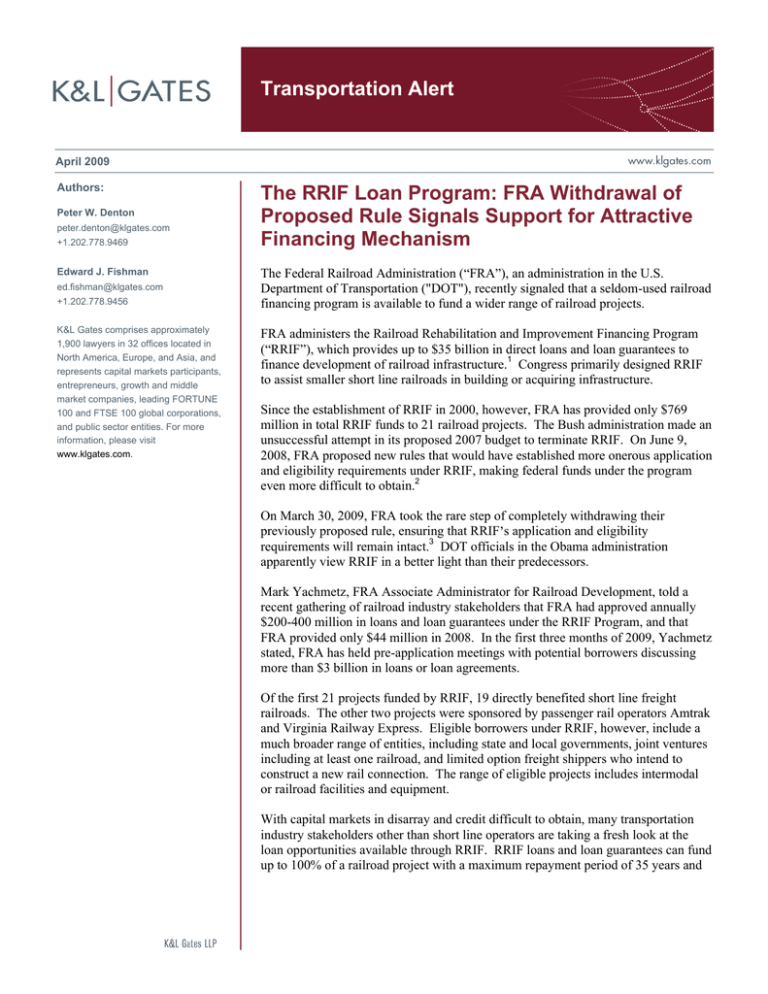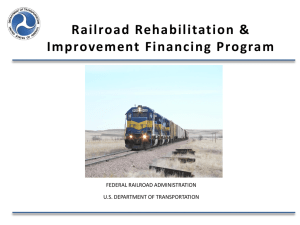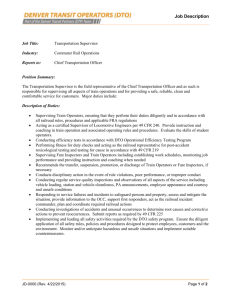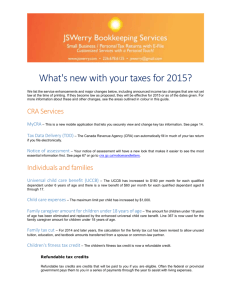
Transportation Alert
April 2009
Authors:
Peter W. Denton
peter.denton@klgates.com
+1.202.778.9469
Edward J. Fishman
ed.fishman@klgates.com
+1.202.778.9456
K&L Gates comprises approximately
1,900 lawyers in 32 offices located in
North America, Europe, and Asia, and
represents capital markets participants,
entrepreneurs, growth and middle
market companies, leading FORTUNE
100 and FTSE 100 global corporations,
and public sector entities. For more
information, please visit
www.klgates.com.
The RRIF Loan Program: FRA Withdrawal of
Proposed Rule Signals Support for Attractive
Financing Mechanism
The Federal Railroad Administration ( FRA ), an administration in the U.S.
Department of Transportation ("DOT"), recently signaled that a seldom-used railroad
financing program is available to fund a wider range of railroad projects.
FRA administers the Railroad Rehabilitation and Improvement Financing Program
( RRIF ), which provides up to $35 billion in direct loans and loan guarantees to
finance development of railroad infrastructure.1 Congress primarily designed RRIF
to assist smaller short line railroads in building or acquiring infrastructure.
Since the establishment of RRIF in 2000, however, FRA has provided only $769
million in total RRIF funds to 21 railroad projects. The Bush administration made an
unsuccessful attempt in its proposed 2007 budget to terminate RRIF. On June 9,
2008, FRA proposed new rules that would have established more onerous application
and eligibility requirements under RRIF, making federal funds under the program
even more difficult to obtain.2
On March 30, 2009, FRA took the rare step of completely withdrawing their
previously proposed rule, ensuring that RRIF s application and eligibility
requirements will remain intact.3 DOT officials in the Obama administration
apparently view RRIF in a better light than their predecessors.
Mark Yachmetz, FRA Associate Administrator for Railroad Development, told a
recent gathering of railroad industry stakeholders that FRA had approved annually
$200-400 million in loans and loan guarantees under the RRIF Program, and that
FRA provided only $44 million in 2008. In the first three months of 2009, Yachmetz
stated, FRA has held pre-application meetings with potential borrowers discussing
more than $3 billion in loans or loan agreements.
Of the first 21 projects funded by RRIF, 19 directly benefited short line freight
railroads. The other two projects were sponsored by passenger rail operators Amtrak
and Virginia Railway Express. Eligible borrowers under RRIF, however, include a
much broader range of entities, including state and local governments, joint ventures
including at least one railroad, and limited option freight shippers who intend to
construct a new rail connection. The range of eligible projects includes intermodal
or railroad facilities and equipment.
With capital markets in disarray and credit difficult to obtain, many transportation
industry stakeholders other than short line operators are taking a fresh look at the
loan opportunities available through RRIF. RRIF loans and loan guarantees can fund
up to 100% of a railroad project with a maximum repayment period of 35 years and
Transportation Alert
interest rates equal to the rate of Treasury securities
of a similar term.4 FRA may require RRIF
applicants to pay an investigation charge of up to
one-half of one percent of the principal amount of
the direct loan or portion of the loan guaranteed
under RRIF.5 FRA calculates a credit risk premium
for the loan based on the creditworthiness of the
borrower.
FRA uses the following criteria and standards to
determine whether to approve an RRIF loan or loan
guarantee for a particular project: (1)
creditworthiness; (2) safety enhancements; (3)
generation of economic benefits; (4) environmental
improvements; and (5) improvements in service or
Anchorage
Los Angeles
Austin Beijing Berlin Boston
Miami
Newark
New York
capacity in the railroad transportation system,
especially in small communities or rural areas.6
The benefits of the RRIF Program are clear: the
program provides applicants with the opportunity to
acquire loans at very competitive rates, with up to
35 year repayment terms and without the need of
any state or local matching funds. In addition, FRA
is authorized to issue up to $35 billion in loans and
loan guarantees under the RRIF Program. One
downside is that many potential borrowers are
beginning to discover the benefits of this program,
which has led to increased competition for these
funds.
Charlotte Chicago Dallas Fort Worth Frankfurt Harrisburg Hong Kong
Orange County
San Diego San Francisco Seattle Shanghai Singapore
Palo Alto
Paris
Pittsburgh
London
Portland Raleigh Research Triangle Park
Spokane/Coeur d Alene Taipei Washington, D.C.
K&L Gates comprises multiple affiliated partnerships: a limited liability partnership with the full name K&L Gates LLP qualified in Delaware and
maintaining offices throughout the U.S., in Berlin and Frankfurt, Germany, in Beijing (K&L Gates LLP Beijing Representative Office), in Singapore
(K&L Gates LLP Singapore Representative Office), and in Shanghai (K&L Gates LLP Shanghai Representative Office); a limited liability partnership
(also named K&L Gates LLP) incorporated in England and maintaining our London and Paris offices; a Taiwan general partnership (K&L Gates)
which practices from our Taipei office; and a Hong Kong general partnership (K&L Gates, Solicitors) which practices from our Hong Kong office.
K&L Gates maintains appropriate registrations in the jurisdictions in which its offices are located. A list of the partners in each entity is available for
inspection at any K&L Gates office.
This publication is for informational purposes and does not contain or convey legal advice. The information herein should not be used or relied upon
in regard to any particular facts or circumstances without first consulting a lawyer.
©2009 K&L Gates LLP. All Rights Reserved.
1
The Transportation Equity Act for the 21st Century ( TEA21 ) established RRIF in 1998. In 2000, FRA promulgated
implementing regulations. FRA approved the first RRIF
project in 2002. The Safe Accountable, Flexible and
Efficient Transportation Equity Act: A Legacy for Users
( SAFETEA-LU ) increased total authorized loans and loan
guarantees under RRIF from $3.5 billion to $35 billion, of
which up to $7 billion is reserved for short line railroads.
The RRIF statute is codified at 45 USC §§ 822-23 and FRA
implementing regulations are found at 49 CFR Part 260.
2
73 Fed. Reg. 32515 (June 9, 2008).
3
74 Fed. Reg. 14104 (March 30, 2009).
4
49 CFR § 260.9.
5
49 CFR § 260.11.
6
See 49 CFR §§ 260.7, 260.17.
Insert Date Here
2






